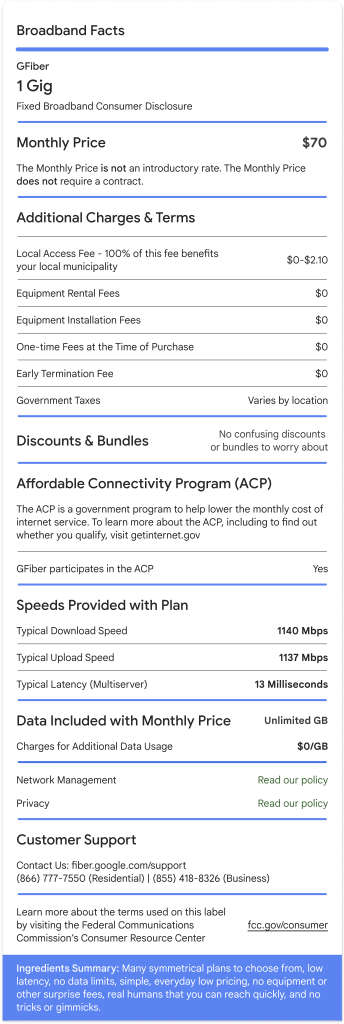April 10, 2024
The FCC’s "Broadband Consumer Labels” put customers in control, and that’s a good thing for ISPs
We’re living in the age of broadband internet — internet service providers (ISPs) are announcing major infrastructure investments, committing to fund significant network upgrades and building new high speed service in communities across the country. At the same time, the federal government is also investing unprecedented amounts to support the deployment of broadband in underserved areas. Given the ubiquity of the internet in our daily lives, these efforts are both long overdue and not enough to give customers what they really need from their ISP — yes, fast, reliable internet, but also a redefined customer experience that is both easy to navigate and to understand.
As part of its effort to improve broadband service nationwide — not just in terms of speed but also in terms of customer experience — the federal government is requiring all ISPs to provide broadband “nutrition labels” on their websites when purchasing service. The point of these labels is similar to the nutrition label on a cereal box (or any other food). They are designed to help consumers make clear comparisons between broadband plans based on key factors such as price and speed and to help them understand what they get for their money.
This type of transparency is a part of Google Fiber’s origin story. Google was built on the idea that information is powerful. And finding the information you need when you need it can change the game. In fact, doing this made the internet navigable — a digital world where information was readily and easily accessible to anyone online. Historically, easy and transparent are not words that many people would associate with ISPs, and that has to change. Nutrition labels are a start in the right direction for our industry.
Choice, and even more importantly, understanding that choice, benefits customers. Informed customers are happier customers. Since the very beginning, ISPs have played confusing games when it comes to price and speed. From that mysterious 13-month price bump to incurring extra fees for everything from equipment to data usage, it can be impossible to know what you are actually getting for your monthly payment (or even what that monthly payment will be).
That’s why GFiber has been fully supportive of the FCC’s broadband labels from the very beginning, and why we launched them early last October — six months ahead of this month’s deadline. These labels empower the consumer and set up a strong foundation for what will hopefully be an extremely long term & satisfying relationship for customers.
And that’s a big change. As an industry, when it comes to customer trust and satisfaction, we’re only beating gas stations. We have a lot of work to do. Internet access isn’t a luxury — it’s a basic need in a world where more and more of our lives are online. Helping customers understand what they are paying for, not only in terms of speed, but also the additional information on the broadband label, like additional charges for equipment rentals, installation fees and/or data caps, has the potential to change the ISP industry’s behavior radically. (Note: GFiber does not have these types of additional fees.) GFiber aspires to be a big part of that change — it’s what we’ve been working towards for the last twelve years and what we bring more places as we grow.
The FCC’s broadband labels put all the information out there, giving customers control so they can make the decision that works best for their households. Everything is on the table, so there’s nowhere for disingenuous tactics to hide.
As a country, we’re making a huge investment in our internet infrastructure. Initiatives like this one will help make sure that customers are getting a return on that investment, improving the overall customer experience and ensuring more transparency across the industry. And that’s a very, very good thing for all of us.
Posted by Dinni Jain, CEO
